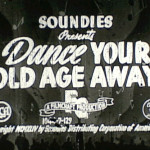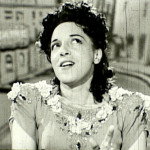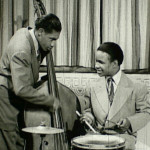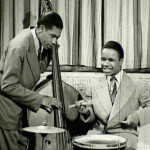THE SOUNDIES
SKEETS TOLBERT AND TOSH HAMMED

By Mark Cantor
Filmcraft Productions
Filmcraft Productions was one of many production units that provided SOUNDIES to the Mill Novelty Company, to be distributed through their “operations unit,” Soundies Distributing Corporation of America. Filmcraft was headed by William Forest Crouch, former publicity director for Soundies Distributing Corporation. Crouch had served as producer and director for Soundies Films, Inc., which produced SOUNDIES on the East Coast in the year before Filmcraft was established. Filmcraft began production in late 1943 and released close to 480 SOUNDIES before ceasing production in early 1947. The Filmcraft output includes not only important jazz, popular and radio stars, but also a high number of African-American artists. William Forest Crouch produced and directed most of the company’s SOUNDIES, working out of Filmcraft Studios in the Bronx.
Introduction
Filmcraft session #44 has all of the elements of a superior series of SOUNDIES: a black “jump band” from 1944 that includes notable, if somewhat obscure, jazz artists; a band unrecorded at this point in time; strong visual coverage of the musicians,;competent and unobtrusive dance routines; and many jazz solos… these are the things that a dream session is made of.
Yet, somehow this series of SOUNDIES falls just a little short, and does not seem to measure up to all of its expectations. While comparison is somewhat unfair, these performances are just not as unified or exciting as similar ones by Louis Jordan, Dallas Bartley or Roy Milton. Perhaps it is a matter of tune selection, obscure songs by Tolbert and others, that are not all that interesting.
On the other hand, while the session does not break any new ground, the films do not disappoint. The arrangements are all well written, and they are played with a great deal of musical cohesion. More important, we have four outstanding solo performances by Leonard Hawkins, one of the unheralded trumpets soloists in the transition from Swing to bebop.
Skeets Tolbert
Campbell “Skeets” Tolbert, was born in 1909, in Calhoun Falls, South Carolina. His earliest musical experiences were in territory bands, and Tolbert made his recording debut in 1931, performing as alto saxophonist and vocalist in a group billed as Taylor’s Dixieland Orchestra. Five years later he again recorded in Charlotte, this time with Jimmy Gunn and his Orchestra.
By the mid 1930s, Tolbert had relocated to New York City, where he joined the very active jazz scene. Howard Rye, writing in the Grove Jazz online site, notes that Tolbert played with Charlie Alexander, and then moved on to the Savoy Ballroom house band. In 1936 Tolbert was with Fats Waller, and then played in a band fronted by Olympic star Jesse Owens. “Shortly afterwards,” writes Mr. Rye, “he joined Snub Mosley’s band, and took control of it after Mosley’s departure.” When the band finally recorded in 1939, the six-piece combo was billed as “Skeets Tolbert and his Gentlemen of Swing.”
Playing in a style that would soon be associated with Louis Jordan, Skeets Tolbert and his Gentlemen of Rhythm recorded forty titles for Decca Records between March 1, 1939 and July 25, 1942. With not a single standard among the forty records, Tolbert’s band was clearly recording for the jukebox trade. The songs, lively jump tunes and slower blues performances, were meant to be danced to in cafes, clubs or one’s living room. While Tolbert is featured on alto sax and clarinet, other well known sidemen included Carl “Tatti” Smith, Lem Johnson, Freddie Jefferson, Red Richards and Buddy Johnson.
In 1946 Tolbert completed studies at Columbia University, disbanded, and moved back to Charlotte where he taught high school. He later joined the faculty at Texas Southern University, and completed his career, as a union official (American Federation of Musicians local 65-699). Tolbert passed away in November, 2000.
The Band
The band that Tolbert was leading in 1944 shared none of the personnel from the the earlier group. In addition, either producer William Forest Crouch, or perhaps Tolbert himself, cast off the “Gentlemen of Rhythm” moniker. The group was now billed simply as “Skeets Tolbert and his Orchestra.”
The trumpet player in the group is Leonard Hawkins, a very capable soloist who never led a recording date of his own. He is best known as a sideman on Swing and early bop dates led by such musicians as Dexter Gordon, Eddie Safranski, Eddie Heywood, Billy Eckstine and Tadd Dameron. He is, in many ways, the strongest soloist on the date. Hawkins has a big tone, in the manner of Freddie Webster, without any of the “schmaltziness” that one associates with Harry James’s ballad style.
Hawkins would not make his recording debut until 1946, a seminal bebop date led by Dexter Gordon. The group recorded for Savoy Records, with Bud Powell on piano, Curly Russell on string bass, and Max Roach on drums. Here, a year and a half earlier, Hawkins is an confident, fully-formed jazz soloist. His ideas are imaginative, and he has a strong technical command of his instrument. At this point in time, Hawkins’s conception is within the Swing tradition, and there are only a few signs of bebop in his work.
String bassist Ebenezer Paul is an equally fabled jazz musician. He was a member of the Minton’s house band at a time when Charlie Christian, Charlie Parker, Thelonious Monk and others sat in regularly as they worked out the foundations of bebop. Paul did not recorded commercially, although he is present on some of the Jerry Newman recordings from Minton’s and Monroe’s. Paul had appeared on the Panoram screen earlier, in a series featuring the Musical Madcaps (Soundies session #16). He returns to SOUNDIES in this series, and even had some brief solo spots (well recorded, at that) on CORN PONE.
Pianist Robert Harley who plays in a competent, if undistinguished manner. He seems to be only a name in jazz discographies, recording in May 1945 with Dud Bascomb for the DeLuxe label. Of tenor sax Alfred Page and drummer Joseph Nicholas nothing is known.
The band is well rehearsed, and it acquits itself well on all of the arrangements, which are almost certainly by Tolbert or a member of the band. Interestingly enough, the routines are similar in all of the SOUNDIES that feature the band on screen: vocal chorus, followed by a chorus split between Tolbert and trumpeter Leonard Hawkins. This is followed by a piano outing by Harley, an occasional eight bars by Page, and then another solo by Tolbert before the out chorus.
Tosh Hammed
Tosh Hammed was long a “mystery man” in jazz music, with just one entry in the standard discographies (a recording with Butterbeans and Susie from 1927) as evidence of his involvement in the music. However, an article by Howard Rye and Robert Ford, published in the Dutch discographic publication, Names & Numbers #64, (January 2013), completely rewrites Hammed’s biography, filling in details that one would have thought to be lost to time.
Tosh Hammed was born George Paxton in September 1893, and was performing as a one-string fiddle player by 1911. During the teens, he toured along the East Coast, performing in Boston and, in January 1914, the Lafayette Theater in Harlem.
Rye and Ford provide a fascinating and detailed chronology of his musical associations and performances throughout the teens and 1920s. In January 1926, for example, Hammed was with The Five Crackerjacks. In 1926 and 1927, he performed in New York City and Chicago, appearing at times with Eddie Heywood’s Jazz Band, and the vaudeville team of Butterbeans and Susie. Playing his one-string fiddle, and working along with pianist Eddie Heywood, Hammed accompanied Butterbeans and Susie on an Okeh recording date in March 1927. The following years, now billed as “One String Willie,” Hammed record again, this time for Columbia, accompanying Lionel O. Licorish. The Pittsburgh Courier (January 1926) notes that Hammed was a member of a revue at Chicago’s Plantation Club, along with King Oliver and his Dixie Syncopators.
Hammed’s activities in the early 1930s have not come to light, but the trades reveal evidence of his work throughout the second half of the decade: a revue at the Apollo Theater (8/23/35), a tour of Europe (with a group billed as The Five Ebonites) (1936-37), and a gig at the West End Theater, New York (1940), just to name a few.
Rye notes, “From 1943 he seems to have devoted himself mainly to arranging and song writing.” Dan Burley, writing in the New York Amsterdam News (12/4/43), notes, “this little arranging shark has a guaranteed course to teach anyone to write his own melodies within a week.” It was during this period that Hammed was called upon to appear in the SOUNDIE Dance Your Old Age Away. It is quite possible that Hammed approached Fritz Pollard of the Sun Tan Studios, or perhaps William Forest Crouch, with the idea of turning his song into a SOUNDIE. The lyrics of the song more or less demand the dress and makeup as an a bearded white haired man.
Subsequent To his SOUNDIES appearance, Hammed continued to write and publish music, presumably appear in public, and record for small record labels. He recorded with the Chic-Chocs, a female vocal group, ca. January 1947 and, the same month, under his own name, “Tosh (One-string Willie) and his Jivesters.” He also made an appearance on piano on the Milton Berle Show.
Sometime in early 1953 Hammed was killed in a fall in New York City.
Lupe Cartiero
Little is known about vocalist Lupe Cartiero (her name is misspelled “Lucy” in some production documents), although she can be found on a 1947 recording with Bill Johnson and his Musical Notes. Cartiero has a fine voice, and she interprets the material well, making us wish that she had been included on more than one titled in this series. Production documents confirm that Miss Cartiero wrote her featured song, Corn Pone. It is not known if Cartiero was working with Tolbert at the time, or if she brought the arrangement of her song to the session.
The Suntan Sweeties
The four dancers billed as “The Suntan Sweeties” were undoubtedly provided by Fritz Pollard’s Sun Tan Studios in Harlem. Sun Tan Studios was a talent agency that booked black performers for clubs, stage shows and films. In this case they, probably turned to the dancers at the Club Zanzibar, “The Zanzibeauts,” who appear unbilled in many SOUNDIES produced by Filmcraft Productions.
“And Company”
The phrase “and Company” refers to the six dancers who appear with Tosh Hammed in Dance Your Old Age Away. Only two of these dancers have been identified. SOUNDIE performer Jeanne Bayer notes, “I recognize two of the dancers in this SOUNDIE. The dancer who is third from the right, that’s Barbara Dunn, and next to her, to the right of her, that’s Marion Egbert. Marion was very active at the time and she was in clubs and also at the Apollo Theater.”
Rosemary
Nothing is known of the sideline extra billed as “Rosemary” in the SOUNDIE ‘Tis You, Babe.
The Skeets Tolbert SOUNDIES – Release Schedule
The first SOUNDIE in the series, Dance Your Old Age Away, was released as the eighth film (a spot often reserved for black performers) in the reel of eight shorts released the week of February 5, 1945. No, No, Baby was released the week of March 26, 1945, as a part of a “Victory Program” that included two new black SOUNDIES, along with six reissue films by white artists. The remaining SOUNDIES, Blitzkrieg Bombardier, Corn Pone and ‘Tis You Babe were released between March and September 1945 as “Limited Distribution Subjects.” This series was composed of black cast films that could be specially ordered by Panoram owners, presumably located in black urban neighborhoods.
Dance Your Old Age Away – “Tosh Hammed and Company”
Glandular transplants or injections, in this case involving monkey testicles, is unusual content for any popular song, but such is the case in Dance Your Old Age Away. The thought that monkey glands possessed important medical benefits was propagated by Russian physician Serge (Samuel) Voronoff. In the 1930s over 500 Frenchmen were treated to various forms of his “rejuvenating therapy.” Indeed, the monkey glands that Hammed sings about allow him and six female dancers, all dressed as elderly folk, to perform with renewed energy and pep.
The song was written by Hammed, and presumably sung by him on soundtrack, although there is no direct evidence of this in the production files. Hammed sings a full chorus of his song both at the beginning and ending of the SOUNDIE. The middle choruses are largely arranged with boppish riffs, along with Skeets Tolbert’s highly energized alto sax taking the releases. Hammed’s dancing is highly energetic and acrobatic and, if his technique is not at the level of other Harlem dancers, he certainly proves that the monkey glands are working well for him!
No No Baby – “Skeets Tolbert and The Suntan Sweeties”
This SOUNDIE opens in a stage setting with “Harlem Revue” printed on the curtain behind Skeets. There will ultimately be four chorus girls on stage with him (The Suntan Sweeties), with the band being placed in the pit below. Tolbert sings the lyrics to the song; at a guess, this song was written by Tolbert or a member of the band.
Tolbert’s alto solo brings to mind other “jump style” stylists, such as Pete Brown, Louis Jordan, Lem Johnson, and Earl Bostic. However, the most impressive soloist here, and throughout the date, is Leonard Hawkins. He has a warm, full sound, and a comparison between Hawkins and the fabled Freddie Webster is certainly appropriate. His improvisation is creative, and he doesn’t miss a note. In comparison, Robert Harley’s solo here, and elsewhere on the date, is more predictable. Firmly grounded in the Swing tradition, they certainly do not break any new ground. All the girls dance and gyrate on stage. A drum break brings on the final arranged chorus, well written and performed by the sextet. Tolbert takes the last bridge, and the SOUNDIE swings to an end.
Blitzkrieg Bombardier – “Skeets Tolbert and his Orchestra”
At first glance, and perhaps first viewing, here we have another wartime SOUNDIE meant to boost patriotism and morale. But the Tolbert’s lyrics actually refer to something else: “Up and down, up and down, have you got it, hold it… Once you’re up, then you’re down… Take your stick in hand, and man it, pull it up, push it down…” While this went completely over the heads of the censors, here we have clearly entered the realm of sexual double entendre.
The setting here is a night club, although we quickly move up to focus on the band. The musical routine is similar to that noted above: vocal chorus, alto solo split with trumpet, vocal, piano and another alto chorus. Here, however, we add a dance routine — dancer unknown — and as rudimentary as it is, it fits well into the overall presentation. The alto solo once again brings Pete Brown and Lem Johnson to mind. The pianist seems to have listened to Nat Cole, although he doesn’t have Cole’s technique, nor the audacity of Cole’s creative ideas. The out chorus ensemble is again strong, both in arrangement and execution.
Corn Pone – “Skeets Tolbert and his Orchestra with Lupe Cartiero”
We return to the stage setting of ‘Tis You Babe, with a slight change only in the curtains in back of the band. The obscure Lupe Cartiero takes the vocal on this rather bizarre song: Mom has almost died during childbirth, there is a mouse loose in the kitchen, and election day fights are going on in the street. In addition, Sis is playing Aida by Faust on the piano! (Would love to hear that!) Through all of this, “Papa’s in the kitchen eating Corn Pone.” Lupe Cartiero has a wonderful voice, somewhat classical in sound, although she is able to swing even these unusual lyrics.
Leonard Hawkins lead is strong on this piece, and we even get a bit of Alfred Page’s tenor sax. His work is within the Swing tradition, nothing exceptional, but certainly some nice ideas. On the other hand — and this is a wonderful surprise — Ebenezer Paul “trades twos” with drummer Joseph Nicholas. The bass is very well recorded and exposes us to a creative, inventive string bass player who is clearly in the Blanton / Pettiford tradition.
‘Tis You Babe – “Skeets Tolbert and his Orchestra with Rosemary”
It appears that William Crouch’s production manager relied on two standing sets for the four SOUNDIES in this series. Here we return to the night club used in BLITZKRIEG BOMBARDIER. Once the music begins, we are distracted only a few times with cutaways to the bar and club patrons. Skeets takes the vocal, and it should be noted that he has a much better voice than most band leaders who sing with their band. The dancer to whom he sings is identified in the opening credits as “Rosemary,” and the production files fail to provide a last name.
The routine in this SOUNDIE — the song is written by Tolbert — follows the formula used in the other films in the series. There is a split chorus with Tolbert playing in his jump style (accompanied by trumpet and and tenor sax), followed by another fine solo by Hawkins, in a manner typical of “late Swing” improvisers. Hawkins control is superb, and his solo is full of bright ideas. Tolbert’s second alto chorus includes some double time runs, more in line with Earl Bostic, as opposed to the boppers. The piano solo is again merely functional. Strong, propulsive drums drive the out chorus.
Evaluation
The Tosh Hammed SOUNDIE is an important piece in itself, preserving on film the image of one of the more obscure performers in African-American entertainment. Not a defining moment, to be sure, but one that allows us to see Hammed’s image, and to experience what he might have been doing on stage during this period in his life.
As noted in the introduction, the four SOUNDIES featuring Skeets Tolbert’s band fall just a bit short of some of the other important black SOUNDIES. Having said that, we must note that there are not many examples of authentic Harlem “jump bands” on film, and this is an important entry in that particular sub-genre. Tolbert himself is a talented reedman, vocalist and leader. However, from a musical point of view, the most important musician is clearly Leonard Hawkins. Technically assured, possessed of a strong, golden tone, imaginative and musically articulate, all of these describe an vastly underrated talent.
The well rehearsed performances of these four tunes suggest that this was not a pick up band put together for a lone SOUNDIES session. While nothing can be located in Hoffman’s Jazz Advertised, one might surmise that the band was in residence in a smaller Harlem club, or perhaps one out in Brooklyn, The Bronx or Queens. Like so many other SOUNDIES from the period, we are offered a rare trip in a cinematic time machine: this is the way it was back in 1944 and, for a few brief minutes, we are there!
Editor’s Note: This article is part of a series on The Soundies, an amazing phenomenon of the film industry which has given the world some wonderful performances by famous and near-famous, as well as some lesser-know musicians. Today’s music videos are descended from The Soundies.
This article is also being published simultaneously by: The IAJRC Journal and the Dutch discographic magazine Names and Numbers. IAJRC is The International Association of Jazz Record Collectors.












